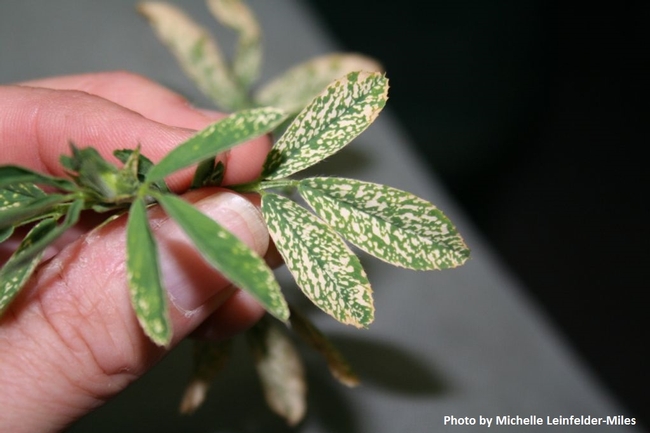In late August, I was requested by a crop consultant to visit an alfalfa field in the Delta that was exhibiting symptoms like those in the picture. The leaves had little white spots near the margins, and generally, the plants had not grown well after the previous cutting. These symptoms are characteristic of potassium (K) deficiency. Delta soils are often deficient in K, so the consultant was going to follow-up with a soil nutrient test.
Fall is the season in which to address alfalfa fertilizer needs. Two nutrients that alfalfa frequently needs are phosphorus (P) and K. [Nitrogen fertilizer (N) is seldom required or profitable in alfalfa because root nodules contain N-fixing Rhizobium bacteria.] P and K should be applied between October and February because it could take 60-90 days for the crop to fully respond to fertilizer application.
A deep-rooted crop, alfalfa can scavenge nutrients from where other crops cannot, but because it has a long growing season, alfalfa has a long season of nutrient demand. Additionally, each cutting removes large amounts of nutrients with the plant tissue. Therefore, proper nutrition is important in maintaining alfalfa yield and quality year after year.
P – important for seedling vigor, root development, and early season growth – is the most commonly deficient nutrient because it can get tied up by the soil. P deficiency may be difficult to diagnose because it can be mistaken for moisture stress, but in general, plants are stunted and have smaller leaves. K is often required because large amounts of it are removed with each cutting. Additionally, sandy soils and/or soils with a long history of alfalfa production can be low in K.
Soil sampling is a reliable way to assess P and K deficiency, but tissue sampling is another way to test for deficiency. P is deficient when soil levels are 4-P (when plant samples are taken at 1/10 bloom). K is deficient when soil levels are 1/10 bloom).
Use a granule (0-45-0, 11-52-0) or liquid (10-34-0) fertilizer to correct P deficiency. These sources are the most economical. If soil or plant tissue tests show deficient levels, then apply P at a rate of 120-180 lbs P2O5/acre (if yield was around 8 tons/acre) and at a rate of 180-270 lbs P2O5/acre (if yield was around 12 tons/acre). Use muriate of potash (0-0-52) to correct K deficiency, or use potassium sulfate (0-0-52, 18% sulfur) if sulfur was also deficient. Correct K deficiency by applying it at a rate of 300-400 lbs K2O/acre (if yield was around 8 tons/acre) and at a rate of 400-600 lbs K2O/acre (if yield was around 12 tons/acre). Single applications of P should not exceed 100-150 lbs P2O5, and single applications of K should not exceed 200-300 lbs K2O. If soil or tissue tests indicate that higher rates are needed, then apply half of what is needed in late fall/early winter and the other half after the second or third cutting. Both P and K are effectively taken up by plants whether pre-plant incorporated or surface applied in established stands. Use these rates to guide your fertilizer applications – remembering that soil type, climate, and yield will influence fertilizer needs – and keep good records of all laboratory results, fertilizer applications, and crop observations. These records will be helpful in developing a long-term, economical fertilization program.
Additional information on how to soil and tissue sample, as well as tables to guide adequate nutrition, are available from this handout.